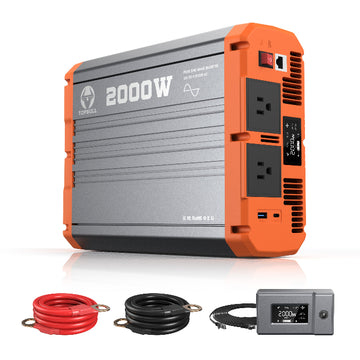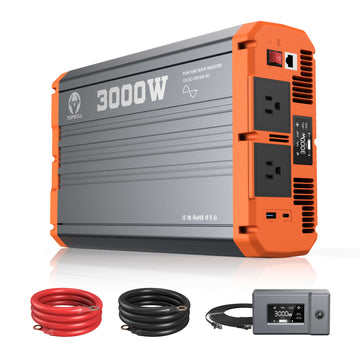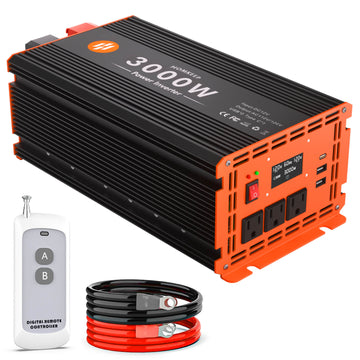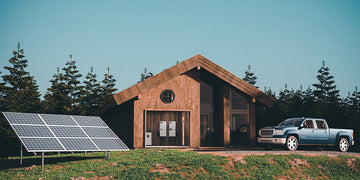When considering connecting an inverter to your car battery, the first question we need to clarify is: how much power can your car battery actually support an inverter? Typically, a 12-volt car battery can support an inverter with a power range of about 150 watts to 1500 watts. Please note, however, that car batteries are not suitable for driving high power inverters for extended periods of time, which may cause damage to the battery. When using a high power inverter, it may be necessary to consider a battery with additional deep cycles to ensure that the car battery is not damaged by continuous discharge. For standard automotive batteries, it is recommended that inverter power not exceed 600 watts for safety and battery life.
This guide is designed to help you make an informed choice about how much power you can use from your car's battery to power an inverter, taking into account a number of key factors such as battery capacity, inverter efficiency and the total power of the equipment you plan to power.
Understand basic car battery parameters
To answer this question, we first need to understand the basic parameters of the vehicle battery.
Rated voltage of the vehicle battery
Most cars use 12V batteries, some larger vehicles may use 24V batteries. This (kind of) voltage specification helps define the input requirements of the inverter.
Battery current rating
The capacity of a battery is expressed in Ampere hours (Ah). Knowing the Ah value of a battery helps evaluate how large an inverter can be supported.
Battery capacity and continuous discharge capability
Batteries do not discharge indefinitely and it is critical to understand their discharge characteristics. Each battery has a safe discharge range beyond which battery damage may result.
Calculating inverter demand sizing
There is a theoretical limit to the amount of inverter power that can be supported by an automotive battery. Theoretically, the maximum supported inverter power can be calculated by multiplying the battery capacity (Ah) by the battery voltage (V) multiplied by the discharge multiplier (C-rate). However, in practice, factors such as inverter efficiency, battery discharge depth, vehicle electrical system limitations, and safety margins need to be considered. The higher the inverter efficiency, the shallower the battery discharge depth, the more stable the vehicle electrical system, the more flexible the selection of inverter power. At the same time, in order to ensure the long-term stable operation of the battery and inverter, it is recommended that a certain safety margin be retained in the calculation results.
To determine the maximum inverter power that your vehicle's battery can support, you need to know the battery's rated voltage (12V for most automotive batteries) and the number of ampere-hours (Ah). For example, a 100Ah battery could theoretically provide 1,200 watts of continuous power (calculation: voltage times ampere hours, i.e., 12V × 100Ah = 1,200W).
However, due to inverter efficiency and actual power usage, it is not recommended to set the load to 100% of the actual battery capacity. It is generally recommended to set it to about 80%, which is more prudent. Taking a 100Ah battery as an example, the recommended maximum inverter power is 960W (1200W × 0.8).

Car inverter size recommendation
Typical usage scenarios and Power Requirements
| Scenario | Recommended Power Range | Example Devices |
| Cell phone charging | 100W-200W | Cell phones, tablets, Bluetooth headsets |
| Laptop | 200W-400W | Mainstream laptops, small fans |
| Small home appliances | 500W-1000W | Car refrigerator, projector |
| High-power equipment | Above 1500W | Electric drill, coffee maker |
Inverter Size and Portability Recommendations
Compact Inverter (100W-300W)
Suitable devices: small appliances, such as cell phone chargers, laptops, LED lights, mini electric knives, etc.
Portability: Ideal for short distance travelers due to its small size and light weight, it is easy to carry and meets basic power needs.
Medium Inverter (500W-1000W)
Suitable equipment: Medium power appliances, such as small refrigerators, rice cookers, fans, and medium-sized electric drills.
Portability: relatively heavy, suitable for fixed installation or use in car, providing more stable power output.
Large Inverter (2000W or above)
Suitable for equipment: High-power equipment, such as refrigerators, air conditioners, large power tools, etc.
Portability: usually requires professional installation, suitable for long-term outdoor work or as a backup power supply application scenarios.
Tip: When using a high-power inverter, if the load exceeds the capacity of the car battery, it is recommended to upgrade to a high-performance deep-cycle battery and consider adding additional deep-cycle batteries. This not only meets the high power demand, but also effectively prevents damage to the car battery and ensures safe and stable operation of the system.
Deep Cycle Battery and High Performance Inverter Recommendations
The selection of deep cycle batteries and high performance inverters is critical in high load situations. Here are some recommended deep cycle batteries and high performance inverters for scenarios with high power applications such as RV, camping or emergency power.
12V 100AH LiFePO4 Deep Cycle Lithium Battery

Product Features
- Ultra-long life: Cycle life is up to 2000-5000 cycles, 8-10 times longer than lead-acid batteries.
- High energy density: compared with lead-acid batteries, its usable capacity is doubled while its weight is reduced by 30%.
- No memory effect: the battery maintains a better state of charge when idle and does not lose capacity due to its previous discharge state.
- Intelligent BMS Protection: Built-in Battery Management System (BMS) effectively prevents over-charging, over-discharging, over-current and short-circuit to ensure battery safety.
- High and low temperature protection: High temperature cut-off function to prevent charging temperature from exceeding 122°F (50°C); meanwhile, low temperature cut-off function is added to avoid irreversible damage caused by low temperature charging.
- Wide applicability: suitable for home energy storage, uninterruptible power supply (UPS) backup, electric vehicles and other fields to meet diversified needs.
Topbull 2000W 12V Pure Sine Wave Inverter

Product Features:
-
High power output: continuous power output up to 2000W, peak power up to 4000W, meet the needs of high-power devices.
-
Diverse interfaces: Equipped with 2 U.S. standard AC power outlets, as well as USB and Type-C fast charging ports, adapting to a variety of charging needs.
-
Wide compatibility: Compatible with all 12V batteries, suitable for scenarios such as RV, camping, self-driving, off-grid living and emergencies.
-
Full protection: 7 built-in protections (overload, overvoltage, undervoltage, high temperature, short circuit, leakage, reverse connection protection) to ensure safe use.
-
Sturdy and durable: adopts aviation-grade aluminum shell, with anti-drop and anti-collision performance.
- Intelligent temperature control: Equipped with dual intelligent temperature control fans to effectively reduce machine temperature and maintain stable performance.
Summarize
The inverter power that can be supported by a car battery needs to take into account the battery capacity, voltage, discharge capability and actual usage requirements. It is usually recommended to limit the load to 80% of the battery capacity to protect the health condition of the battery. For example, if your car battery has a capacity of 100Ah, then it is recommended that the maximum load should be limited to about 900 watts.
When selecting an inverter, match it to the power requirements of the connected equipment and make sure you leave a safety margin to avoid overloading and deep discharging. If a high power inverter is required (e.g. 1000 Watts or more), it is advisable to have a deep cycle battery. These batteries are designed to be discharged for long periods of time and are better able to meet high power demands without causing damage to the car's starting battery.
FAQs.
Can I run a 2000 watt inverter on a car battery?
Yes, you can run a 2000 watt inverter on a car battery, but there are several important factors to consider. Typically, a standard 12-volt automotive battery needs to have enough capacity (Ampere-hours, Ah) to sustain that load without damaging the battery. To be safe, it is recommended to limit the load to 80% of the battery's rated capacity to ensure that the battery can withstand high current loads.
What size battery do I need to run a 3000 watt inverter?
To run a 3000 watt inverter, you will need a significant amount of battery capacity to support the load. The calculation is as follows: at 12 volts, a 3000 watt inverter requires approximately 250 amps of current (3000W / 12V = 250A). Therefore, if you wish to use it continuously for 1 hour, you will need at least 250Ah of battery capacity. For safety and efficient use, it is more recommended to use deep cycle batteries of 300Ah or more, or multiple batteries in parallel to ensure sufficient power and avoid over-discharge.
Will the inverter damage the generator?
Normally, the inverter itself will not directly damage the generator, but a high power inverter will put a large load on the generator. If the power of the inverter exceeds the generator's ability to supply power, this may result in battery drain or stress on the generator. Therefore, it is necessary to ensure that your vehicle's electrical system, including the generator, is capable of supporting the power needs of the inverter and its connected devices.
How long can a 300-watt inverter run on a car battery?
The runtime of a 300-watt inverter depends on the capacity of the battery. For example, if you are using a 100Ah battery, the calculation is as follows: the total battery capacity is 12V × 100Ah = 1200 watt-hours. The runtime is equal to the total watt-hours divided by the power of the inverter, i.e. 1200 watt-hours / 300W = 4 hours (theoretical value). However, the actual runtime may be reduced due to efficiency losses, so you may expect the actual runtime to be about 3-4 hours at full load.
What equipment should not be plugged into the inverter?
There are some devices that are not recommended to be connected when using the inverter. First, avoid connecting high current devices, which may exceed the inverter's power rating. Secondly, for sensitive electronic devices, the use of a modified sine wave inverter may lead to malfunctions; it is better to choose a pure sine wave inverter. In addition, devices such as refrigerators and electric motors pull high currents momentarily during startup and may exceed the inverter's ability to supply power. Finally, devices such as electric heaters and other high power consuming devices are also not suitable for inverter power supply as they consume too much power.












